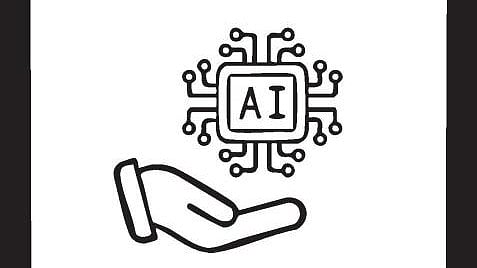
DH Illustration
SHISHIR PRIYADARSHI AND NISHIT PATIL
The transformative power of Artificial Intelligence (AI) has shifted from the realm of theoretical speculation to the forefront of real world applications over the past decade. Historically, modernisation in major sectors often led to concerns about mass layoffs. Over time, many of these disruptions were mitigated by parallel employment growth in emerging industries. AI, however, poses challenges of a far more transformative nature. In light of such developments, a stark reality persists: millions of workers could be displaced as machines learn to carry out tasks once performed by humans. The Union Budget 2025 puts forth several initiatives aimed at nurturing AI innovation while expanding the skill set of India’s workforce, but the devil lies in the details of implementation and scale.
Central to the mission is the announcement of five new National Centres of Excellence (CoEs) in skilling, each with specialised curricula designed to prepare both new entrants and existing workers for the AI-driven future which are envisioned to be developed through global frameworks and partnerships, ensuring that the curriculum remains aligned with the latest international standards. This may include forging agreements with top-tier global institutions and technology companies, so that students and seasoned professionals acquire hands-on experience in operating AI tools, interpreting large datasets, and deploying automated solutions to real world problems. The government’s intention is not merely to equip the youth but to cater to those who need to pivot from traditional roles that are at risk of obsolescence.
Another key component of the budget is the Rs-500 crore AI-powered CoE in Education. This project can serve as a way to transform teaching methodologies, especially in domains where practical experience is as essential as theoretical grounding such as in the medical field. By integrating AI and Virtual Reality (VR) tools into the medical curriculum, students can practise surgeries in a risk-free, virtual environment and master complex anatomical concepts through immersive, interactive simulations. The government’s decision of introducing new Atal Tinkering Labs (ATLs) reflects an overarching approach of instilling a culture of innovation from a young age. These labs are designed to acquaint rural school children to coding, robotics, and other foundational AI skills.
While training the next generation is crucial, the policymakers also grapple with the requirement of re-skilling existing workforce. India has a vast labour force employed in sectors that may be significantly transformed by AI such as manufacturing, call centres, and even software services that rely on relatively routine coding tasks. Recognising that large segments of these workers risk displacement if they do not adapt, the government plans to utilise the new CoEs in skilling and upskilling hubs.
In the realm of fiscal incentives, the budget has taken a two-pronged approach. First, a Fund of Funds (FoF) for Deeptech startups of Rs 10,000 crore, and second, funding support for R&D, earmarking Rs 20,000 crore for encouraging private sector investment in the field. Such measures reflect the belief that India can carve out a place in the global AI ecosystem, as a generator of cutting-edge intellectual property. This collaborative strategy also resonates with India’s broader vision of “Make in India, Make for the World.”
Disruption and course correction
Yet for all these initiatives to bear fruit, we must address issues of digital infrastructure and inclusion. AI-based tools demand reliable connectivity and adequate bandwidth, something that remains elusive in many parts of India. The budget allocation for digital infrastructure includes proposals to expand BharatNet, a government-run project aimed to bring 5G networks to semi-urban and remote districts. In principle, these measures could bridge the digital gap.
One of the more debated topics in the lead-up to the Budget was whether the government would propose direct social security measures to protect those most vulnerable to AI-induced job displacement. There is no explicit mention of an unemployment insurance scheme in the final budget document. Critics argue that without a robust safety net, the semi-skilled workforce, especially in the manufacturing and service sectors, could face abrupt displacement. Proponents of the government’s approach maintain that upskilling efforts will mitigate the potential job loss by opening new opportunities in AI-driven industries. The truth likely lies somewhere in between.
In light of these debates, the formation of a dedicated committee focused on the regulatory aspects of AI-driven labour reforms could serve as an informative authority on the matter. It shall contain representatives from the government, private sector, labour unions, academicians, and subject matter experts to ensure just representation of the labour force. It would help establish guidelines on best practices for both upskilling programmes and worker transition support; it would help standardise skill development methodologies, assess AI-related disruptions in real time, and recommend the necessary course correction.
The path to inclusive AI adoption may incorporate an ongoing dialogue between policymakers, industry and the public. This kind of multi-stakeholder engagement can help identify unforeseen bottlenecks and course correct policies before labour displacement or ethical oversight becomes severe. The Budget stands as a unique embodiment of the concept of IKIG“AI” – India’s Knowledge Induced Growth in Artificial Intelligence, underlining both the abundant promise and the real-world complexities of adopting AI.
While strategic investments signify a step forward, the question of workforce displacement cannot be ignored. By embracing a collaborative approach among the stakeholders, India can fully realise AI’s potential as an economic catalyst, while safeguarding the livelihoods of millions. Ultimately, the sustainability of this IKIG”AI” journey will hinge on how effectively the announced initiatives are implemented, how equitably access to technology is expanded, and how steadfast India remains committed to making AI-driven innovation a force for inclusive growth.
(Shishir is the president of Chintan Research Foundation and an ex- director of the WTO; Nishit is a research assistant at Chintan Research Foundation)
Disclaimer: The views expressed above are the author's own. They do not necessarily reflect the views of DH.